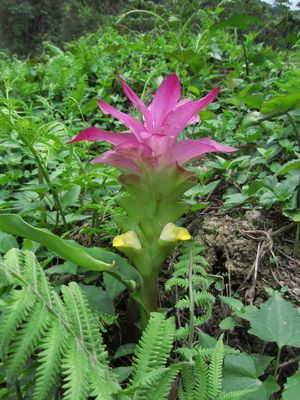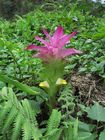Note: This is a project under development. The articles on this wiki are just being initiated and broadly incomplete. You can Help creating new pages.
Difference between revisions of "Curcuma aromatica - Wild turmeric, Aranyaharidra"
m (Prabhakar moved page Aranyaharidra to Aranyaharidra (Curcuma aromatica)) |
|||
| (40 intermediate revisions by 2 users not shown) | |||
| Line 1: | Line 1: | ||
[[File:Curcuma aromatica.jpg|thumb|right|''Kasthuri arishina'', ''Curcuma aromatica'']] | [[File:Curcuma aromatica.jpg|thumb|right|''Kasthuri arishina'', ''Curcuma aromatica'']] | ||
| + | '''Curcuma aromatica''' is a member of the Curcuma genus belonging to the family Zingiberaceae. Botanically close to Curcuma australasica, wild turmeric has been widely used as a cosmetic herbal in South Asia and nearby regions. | ||
| + | ==Uses== | ||
| + | {{Uses|Arthritis}}, {{Uses|Heartburn}}, {{Uses|Joint pain}}, {{Uses|Stomachache}}, {{Uses|Ulcerative colitis}}, {{Uses|Bypass surgery}}, {{Uses|Diarrhea}}, {{Uses|Intestinal gas}}, {{Uses|Loss of appetite}}, {{Uses|Jaundice}}, {{Uses|Liver problems}}, {{Uses|Helicobacter pylori}}, {{Uses|Stomach ulcers}}, {{Uses|Irritable bowel syndrome}}, {{Uses|Gallbladder disorders}}, {{Uses|High cholesterol}}, {{Uses|Lichen planus}}, {{Uses|Fatigue}}, {{Uses|Headaches}}<ref name="Uses"/> | ||
| − | + | ==Parts Used== | |
| + | {{Parts Used|Rhizome}}, {{Parts Used|Oil}}. | ||
| − | == | + | ==Chemical Composition== |
| − | + | Rhizome yields essential oil, containing curdione and curcumol, colouring matter, cucurmin, resin, mucilage, albumionoids, starch, gum and sugar<ref name="chemical composition"/> | |
| − | |||
| − | == | + | ==Common names== |
| + | {{Common names|kn=Kasthuri arishina|ml=Kasthoori manjal, dantmanjal|sa=Aranyaharidra|ta=Kasturimanjal|te=Kasthuri pasupa|hi=Jangli haldi|en=Wild turmeric, Aromatic turmeric}} | ||
| − | + | ==Properties== | |
| + | Reference: Dravya - Substance, Rasa - Taste, Guna - Qualities, Veerya - Potency, Vipaka - Post-digesion effect, Karma - Pharmacological activity, Prabhava - Therepeutics. | ||
| + | ===Dravya=== | ||
| − | == | + | ===Rasa=== |
| + | Tikta (Bitter), Katu (Pungent) | ||
| + | ===Guna=== | ||
| + | Laghu (Light), Ruksha (Dry) | ||
| + | ===Veerya=== | ||
| + | Ushna (Hot) | ||
| + | ===Vipaka=== | ||
| + | Katu (Pungent) | ||
| + | ===Karma=== | ||
| − | + | ===Prabhava=== | |
| − | |||
| − | |||
| − | == | + | ==Habit== |
| + | {{Habit|Shrub}} | ||
| − | + | ==Identification== | |
| + | ===Leaf=== | ||
| + | {{Leaf|Large|Oblong|Up to 1 m long, dark green on upper surface, pale green beneath. Each leafy shoot (pseudostem) bearing 8–12 leaves}} | ||
| − | [[Category:herbs]] | + | ===Flower=== |
| + | {{Flower|Unisexual|10–15 cm long|Yellow-white||Flowers are sterile and do not produce viable seed}} | ||
| + | |||
| + | ===Fruit=== | ||
| + | {{Fruit|oblong pod|Thinly septate, pilose, wrinkled||Small, ovoid, brown. Not viable|}} | ||
| + | |||
| + | ===Other features=== | ||
| + | |||
| + | ==List of Ayurvedic medicine in which the herb is used== | ||
| + | |||
| + | ==Where to get the saplings== | ||
| + | ==Mode of Propagation== | ||
| + | {{Propagation|Seeds}}. | ||
| + | |||
| + | ==How to plant/cultivate== | ||
| + | |||
| + | Turmeric is a low-growing tropical herbaceous plant, which forms many long thin rhizomes<ref name="How to plant/cultivate"/> | ||
| + | |||
| + | ==Commonly seen growing in areas== | ||
| + | {{Commonly seen|Tropical area}}, {{Commonly seen|Subtropical area}}. | ||
| + | |||
| + | ==Photo Gallery== | ||
| + | <gallery class="left" caption="" widths="140px" heights="140px"> | ||
| + | File:Curcuma aromatica.jpg | ||
| + | File:Kasthuri manjal plant with flower.jpg|Leaves | ||
| + | File:Flowers (14).jpg|Flower | ||
| + | File:Kasthoorimanjal.JPG|Leaves | ||
| + | File:കസ്തൂരിമഞ്ഞൾ വേര്.jpg|Rhizome | ||
| + | </gallery> | ||
| + | |||
| + | ==References== | ||
| + | |||
| + | <references> | ||
| + | <ref name="chemical composition">[http://www.mpbd.info/plants/curcuma-aromatica.php Chemical Constituents]</ref> | ||
| + | |||
| + | <ref name="Uses">[https://www.webmd.com/vitamins-supplements/ingredientmono-662-turmeric.aspx?activeingredientid=662&activeingredientname=turmeric Turmeric uses]</ref> | ||
| + | <ref name="How to plant/cultivate">[http://powo.science.kew.org/taxon/urn:lsid:ipni.org:names:796451-1 Cultivation]</ref> | ||
| + | </references> | ||
| + | |||
| + | ==External Links== | ||
| + | * [http://tropical.theferns.info/viewtropical.php?id=Curcuma+aromatica Curcuma aromatica on useful trophical plants] | ||
| + | * [http://www.flowersofindia.net/catalog/slides/Wild%20Turmeric.html Curcuma aromatica on flowers of india] | ||
| + | * [https://herbpathy.com/Uses-and-Benefits-of-Wild-Turmeric-Cid1079 Curcuma aromatica uses, benefits, sideeffects] | ||
| + | * [http://healthyliving.natureloc.com/wild-turmeric-kasthuri-manjal-an-aromatic-medicinal-cosmetic/ Wild Turmeric – Kasthuri Manjal – An aromatic medicinal cosmetic] | ||
| + | * [http://naturalhomeremedies.co/Clonga.html Natural home remedy of Wild Turmeric] | ||
| + | |||
| + | |||
| + | [[Category:Herbs]] | ||
| + | [[Category:Zingiberaceae]] | ||
| + | [[Category:Pages without herbs images]] | ||
Latest revision as of 12:09, 21 April 2020
Curcuma aromatica is a member of the Curcuma genus belonging to the family Zingiberaceae. Botanically close to Curcuma australasica, wild turmeric has been widely used as a cosmetic herbal in South Asia and nearby regions.
Contents
- 1 Uses
- 2 Parts Used
- 3 Chemical Composition
- 4 Common names
- 5 Properties
- 6 Habit
- 7 Identification
- 8 List of Ayurvedic medicine in which the herb is used
- 9 Where to get the saplings
- 10 Mode of Propagation
- 11 How to plant/cultivate
- 12 Commonly seen growing in areas
- 13 Photo Gallery
- 14 References
- 15 External Links
Uses
Arthritis, Heartburn, Joint pain, Stomachache, Ulcerative colitis, Bypass surgery, Diarrhea, Intestinal gas, Loss of appetite, Jaundice, Liver problems, Helicobacter pylori, Stomach ulcers, Irritable bowel syndrome, Gallbladder disorders, High cholesterol, Lichen planus, Fatigue, Headaches[1]
Parts Used
Chemical Composition
Rhizome yields essential oil, containing curdione and curcumol, colouring matter, cucurmin, resin, mucilage, albumionoids, starch, gum and sugar[2]
Common names
| Language | Common name |
|---|---|
| Kannada | Kasthuri arishina |
| Hindi | Jangli haldi |
| Malayalam | Kasthoori manjal, dantmanjal |
| Tamil | Kasturimanjal |
| Telugu | Kasthuri pasupa |
| Marathi | NA |
| Gujarathi | NA |
| Punjabi | NA |
| Kashmiri | NA |
| Sanskrit | Aranyaharidra |
| English | Wild turmeric, Aromatic turmeric |
Properties
Reference: Dravya - Substance, Rasa - Taste, Guna - Qualities, Veerya - Potency, Vipaka - Post-digesion effect, Karma - Pharmacological activity, Prabhava - Therepeutics.
Dravya
Rasa
Tikta (Bitter), Katu (Pungent)
Guna
Laghu (Light), Ruksha (Dry)
Veerya
Ushna (Hot)
Vipaka
Katu (Pungent)
Karma
Prabhava
Habit
Identification
Leaf
| Kind | Shape | Feature |
|---|---|---|
| Large | Oblong | Up to 1 m long, dark green on upper surface, pale green beneath. Each leafy shoot (pseudostem) bearing 8–12 leaves |
Flower
| Type | Size | Color and composition | Stamen | More information |
|---|---|---|---|---|
| Unisexual | 10–15 cm long | Yellow-white | Flowers are sterile and do not produce viable seed |
Fruit
| Type | Size | Mass | Appearance | Seeds | More information |
|---|---|---|---|---|---|
| oblong pod | Thinly septate, pilose, wrinkled | Small, ovoid, brown. Not viable | {{{6}}} |
Other features
List of Ayurvedic medicine in which the herb is used
Where to get the saplings
Mode of Propagation
How to plant/cultivate
Turmeric is a low-growing tropical herbaceous plant, which forms many long thin rhizomes[3]
Commonly seen growing in areas
Tropical area, Subtropical area.
Photo Gallery
References
External Links
- Ayurvedic Herbs known to be helpful to treat Arthritis
- Ayurvedic Herbs known to be helpful to treat Heartburn
- Ayurvedic Herbs known to be helpful to treat Joint pain
- Ayurvedic Herbs known to be helpful to treat Stomachache
- Ayurvedic Herbs known to be helpful to treat Ulcerative colitis
- Ayurvedic Herbs known to be helpful to treat Bypass surgery
- Ayurvedic Herbs known to be helpful to treat Diarrhea
- Ayurvedic Herbs known to be helpful to treat Intestinal gas
- Ayurvedic Herbs known to be helpful to treat Loss of appetite
- Ayurvedic Herbs known to be helpful to treat Jaundice
- Ayurvedic Herbs known to be helpful to treat Liver problems
- Ayurvedic Herbs known to be helpful to treat Helicobacter pylori
- Ayurvedic Herbs known to be helpful to treat Stomach ulcers
- Ayurvedic Herbs known to be helpful to treat Irritable bowel syndrome
- Ayurvedic Herbs known to be helpful to treat Gallbladder disorders
- Ayurvedic Herbs known to be helpful to treat High cholesterol
- Ayurvedic Herbs known to be helpful to treat Lichen planus
- Ayurvedic Herbs known to be helpful to treat Fatigue
- Ayurvedic Herbs known to be helpful to treat Headaches
- Herbs with Rhizome used in medicine
- Herbs with Oil used in medicine
- Herbs with common name in Kannada
- Herbs with common name in Hindi
- Herbs with common name in Malayalam
- Herbs with common name in Tamil
- Herbs with common name in Telugu
- Herbs with common name in Sanskrit
- Herbs with common name in English
- Habit - Shrub
- Index of Plants which can be propagated by Seeds
- Herbs that are commonly seen in the region of Tropical area
- Herbs that are commonly seen in the region of Subtropical area
- Herbs
- Zingiberaceae
- Pages without herbs images





